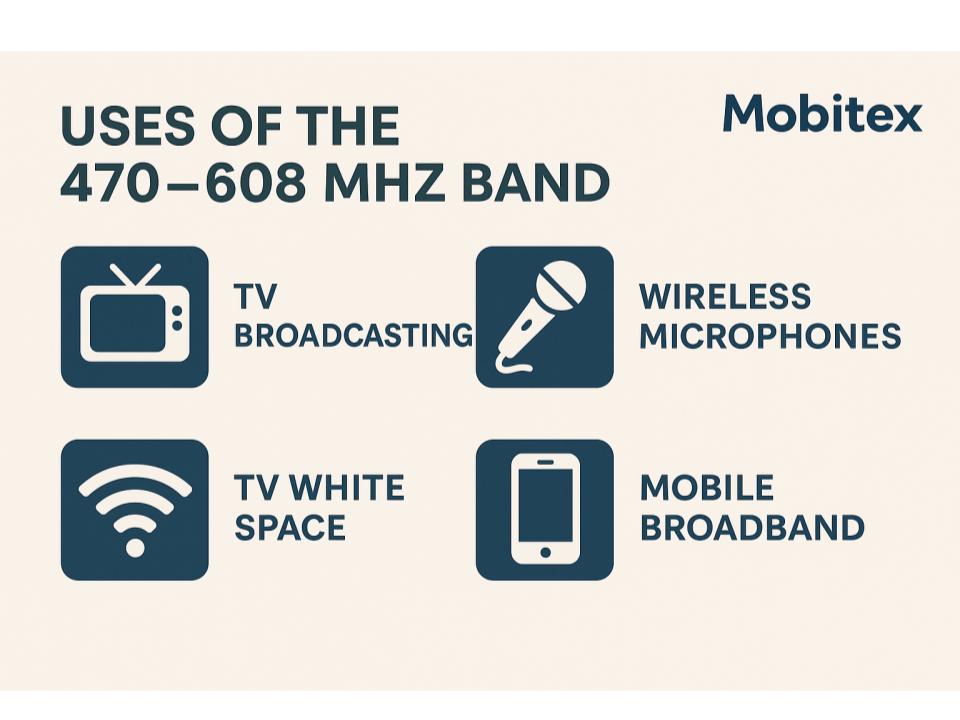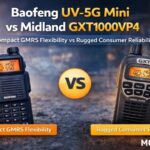Frequency
607 MHz
Range
600–698 MHz
Band Group
UHF (300–1000 MHz)
🌐 Summary
The 607 MHz allocation is part of the UHF (300–1000 MHz) spectrum. This range is used worldwide for critical applications that keep our communications and infrastructure running smoothly. On this page we highlight how each band is applied in real systems, from regulatory assignments to everyday devices. Our goal is to make spectrum data clear and practical for engineers, regulators, and enthusiasts alike.
Key uses of this band include: 607 MHz: UHF TV broadcasting; many countries repurposed to 600 MHz mobile broadband (digital dividend).; Broadcasting, Mobile; UHF TV (post‑repack ranges vary); TV receivers, microphones; live sound, broadcast.
UHF TV Channel 36 (602–608 MHz): digital TV/LPTV; PMSE and TV white‑space allowed regionally.

🔍 Explore the full RF Spectrum database
📡 Band & Geometry key
| Field | Value |
|---|---|
| Wavelength (m) | 0.494 |
| Waveforms | Digital TV (ATSC/DVB/ISDB); LTE/NR 5G (Band 71) |
| Antenna Form Factor (Typical) | ¼-wave ≈ 12.4 cm |
| Band Family | Broadcast |
| Band | UHF TV / Mobile broadband (digital dividend) |
| Primary Common Name | Broadcasting (TV) / IMT (600 MHz band) |
| FSPL @ 1 km [dB] | 88.103773821505 |
| FSPL @ 10 km [dB] | 108.10377382151 |
| Fresnel Radius @ 1 km (m) | 11.115360344354 |
| Band Group | UHF (300–1000 MHz) |
| Tax Band Family | UHF |
| Tax Band Class | UHF TV (470–608) |
🧩 Applications & Usage
| Field | Value |
|---|---|
| Primary Application | UHF TV broadcasting; many countries repurposed to 600 MHz mobile broadband (digital dividend). |
| Lower Neighbor Use | UHF Broadcast TV / Land mobile (regional) |
| Upper Neighbor Use | 700/800 MHz Mobile (IMT) + Public Safety |
| Typical Services Devices | UHF TV (post‑repack ranges vary) |
| Market Common Devices | TV receivers, microphones |
| Refarming Use | No |
| Device Ecosystem Size | Medium |
| Device Hotspots (MHz) | 607 |
| Device Category | Wireless Mic / IEM |
| Typical Use Cases | live sound, broadcast |
| Modulation (Device) | FM / digital QPSK (varies) |
| Channel Width (Device) [kHz] | 100–200 |
| Device Region Profiles | Region-specific TV bands |
| Per-Region EIRP Or Duty (Device) | Low EIRP; licensed use in some regions |
| Allocation Relevance (Device) | Broadcast/auxiliary services |
| Adjacent-Band Collision Risks (Device) | TV carriers adjacent |
| Example Devices Or Skus | Sennheiser, Shure, Lectrosonics |
| Common Protocols | LTE; 5G NR; GSM/EDGE; UMTS (legacy); Digital Terrestrial TV (ATSC/DVB-T) |
🗒️ Notes
| Field | Value |
|---|---|
| Receiver Selectivity Notes | – |
| Interference Notes | White-space device rules in some countries |
| Compatibility Risk Notes | – |
| Notes | UHF TV Channel 36 (602–608 MHz): digital TV/LPTV; PMSE and TV white‑space allowed regionally. |
| Propagation Notes | Strong coverage, good indoor penetration |
⚙️ Technical Rules
| Field | Value |
|---|---|
| Lower Band Frequency Limit | 600 |
| Upper Band Frequency Limit | 698 |
| EIRP Indoor Limits | Licensed broadcast only |
| EIRP Outdoor Limits | High‑power broadcast per permit |
| PSD Limit | — |
| Emission Mask Class | Broadcast TV mask |
| Guardband Minimum [kHz] | 6000 |
| Typical Bandwidths | 5, 10, 20 MHz |
| Autocalculated Bandlimits | No |
| Typical Bandwidths (Estimated) | 5, 10, 20 MHz |
| Max EIRP [dBm] | Low EIRP; licensed use in some regions |
| Power Source Or Duty Profile (Typical) | AA battery belt packs |
| Channelization Plan | 5, 10, 20 MHz |
| Channelization | TV channels (6–8 MHz); LTE/NR 5 MHz blocks |
| Guard Band Requirement | – |
| OOB Emission Limit [dBm/MHz] | -13 (baseline) |
| Spurious Emission Limit (dBm) | -30 (baseline) |
| RX Blocking Min [dBm] | -15 (planning) |
| Duplexing | FDD (600 MHz band in Region 2); N/A for broadcast |
| Duplexing Information | FDD: 617–652 MHz (uplink, Region 2 IMT) uplink / 663–698 MHz (downlink, Region 2 IMT) downlink |
| Uplink Pairing | 617–652 MHz (uplink, Region 2 IMT) |
| Downlink Pairing | 663–698 MHz (downlink, Region 2 IMT) |
| Paired Band Info | – |
| Max EIRP [dBm] | – |
| Channelization Block Size | – |
| 3GPP Band Number | |
| Example 3GPP Bands | – |
| LTE Uplink Bands | – |
| LTE Downlink Bands | – |
| NR Uplink Bands | – |
| NR Downlink Bands | – |
| Guard Bands | – |
| Protocol Or Standard | pro audio wireless |
🌎 Country Overrides
| Field | Value |
|---|---|
| Tax Service Category | Other / Various |
| Tax License Type | Licensed (Exclusive / Auctioned) |
| Tax Regions | Global / Varies |
| ITU Region 1 | Broadcasting |
| ITU Region 2 | Broadcasting, Mobile (IMT) |
| ITU Region 3 | Broadcasting, Mobile (IMT) |
| License Type | Broadcast (licensed); Mobile broadband IMT (licensed, regional) |
| Primary Application | UHF TV broadcasting; many countries repurposed to 600 MHz mobile broadband (digital dividend). |
| Primary Services | Broadcasting, Mobile |
| Spurious Emission [dBm] | -30 (baseline) |
| Lower Neighbor Use | UHF Broadcast TV / Land mobile (regional) |
| Upper Neighbor Use | 700/800 MHz Mobile (IMT) + Public Safety |
| Licensing Model | Licensed (Broadcasting) |
| Typical Services Devices | UHF TV (post‑repack ranges vary) |
| US FCC Alloc | UHF TV (Post-repack ranges)– |
| CA IC Alloc | UHF TV– |
| UK Ofcom Alloc | DTT (UHF TV)– |
| US Ref | – |
| Typical Bandwidths | 5, 10, 20 MHz |
| Market Licensing Model | Licensed (Broadcast) |
| Market Common Devices | TV receivers, microphones |
| Fresnel Radius (1st, 1 km) [m] | 11.115360344354 |
| Typical Bandwidths (Estimated) | 5, 10, 20 MHz |
| Auction Status | – |
| Refarming Use | No |
| Typical Site Spacing km | 2 / 8 |
| Device Ecosystem Size | Medium |
| Traffic Load Share | Coverage-heavy, low capacity share |
| Device Hotspots (MHz) | 607 |
| Device Category | Wireless Mic / IEM |
| Typical Use Cases | live sound, broadcast |
| Typical Center Frequencies [MHz] | 470–608 |
| Rule Part (Fcc Or Region) | FCC Part 74 (US) / national rules |
| Modulation (Device) | FM / digital QPSK (varies) |
| Channel Width (Device) [kHz] | 100–200 |
| Device Region Profiles | Region-specific TV bands |
| Per-Region EIRP Or Duty (Device) | Low EIRP; licensed use in some regions |
| Allocation Relevance (Device) | Broadcast/auxiliary services |
| Adjacent-Band Collision Risks (Device) | TV carriers adjacent |
| Example Devices Or Skus | Sennheiser, Shure, Lectrosonics |
| Antenna Form Factor (Typical) | ¼-wave ≈ 12.4 cm |
| Power Source Or Duty Profile (Typical) | AA battery belt packs |
🛡️ Regulatory & Neighbors
| Field | Value |
|---|---|
| Lower Band Frequency Limit | 600 |
| Upper Band Frequency Limit | 698 |
| Rx Blocking Min dBm | -15 (planning) |
| Lower Neighbor Use | UHF Broadcast TV / Land mobile (regional) |
| Upper Neighbor Use | 700/800 MHz Mobile (IMT) + Public Safety |
| Lower Neighbor Band | UHF Broadcast TV / Land mobile (regional) |
| Lower Neighbor Range | 513.000–600.000 MHz |
| Upper Neighbor Label | 700/800 MHz Mobile (IMT) + Public Safety |
| Upper Neighbor Range | 699.000–806.000 MHz |
| Adjacent-Band Collision Risks (Device) | TV carriers adjacent |
| Real-World Range (Indoor/Outdoor) | Stage to FOH: 30–100 m |
| US FCC Alloc | UHF TV (Post-repack ranges)UHF TV (Post-repack ranges) |
| CA IC Alloc | UHF TVUHF TV |
| UK Ofcom Alloc | DTT (UHF TV)DTT (UHF TV) |
| Regulatory References | US: -; CA: -; UK: – |
| Global Harmonization | Regional |
| Crossborder Coordination | High |
| Sharing Mechanism | – |
| Auction Status | – |
| Guard Or Pair | Duplex gap between UL/DL in Region 2 (652–663 MHz) |
📈 Market & Measurements
| Field | Value |
|---|---|
| Noise Floor | Urban RF noise can be high |
| Interference Cases | TV vs IMT coexistence; adjacent channel leakage; passive radio astronomy interference at 608–614 MHz |
| Lower Neighbor Range | 513.000–600.000 MHz |
| Upper Neighbor Range | 699.000–806.000 MHz |
| Interference Notes | White-space device rules in some countries |
| Market Licensing Model | Licensed (Broadcast) |
| Market Commercial Value | Medium |
| Market Common Devices | TV receivers, microphones |
| Market Deployment Density | Dense urban households |
| Noise Floor (Estimated) | Urban RF noise can be high |
| Market Commercial Value (Estimated) | Medium |
| Ecosystem Maturity | Emerging |
| Indoor Penetration | Good |
| Known Interference | No major interference issues noted |
| Device Ecosystem Size | Medium |
| Real-World Range (Indoor/Outdoor) | Stage to FOH: 30–100 m |
| Antenna Form Factor (Typical) | ¼-wave ≈ 12.4 cm |
| Ecosystem Maturity | Emerging |
| Device Ecosystem Size | Medium |
| Chipset Availability | Limited / TBD |
| Operator Deployments | Limited operators |
| Technology Generations Deployed | Multiple / TBD |
| Roaming Support | – |
| Traffic Load Share | Coverage-heavy, low capacity share |
| Indoor Penetration | Good |
| Known Interference | No major interference issues noted |
| Occupancy | High in TV markets; increasing IMT occupancy |
| Occupancy Bucket Pct | 10–30% |
| Latency Profile | – |
| Common Channels Or Profiles | TV whitespace channels (region-dependent) |
| Security Features | digital links may use AES |
| Lbt Or Fhss Requirement | Coordination required in some regions |
| Popularity (Installed Base) | High |
| Coexistence Tips | Scan spectrum; coordinate channels; directional antennas |
| Latency Class | Low |
| Device Hotspots (Scoped && Tagged) | – |
